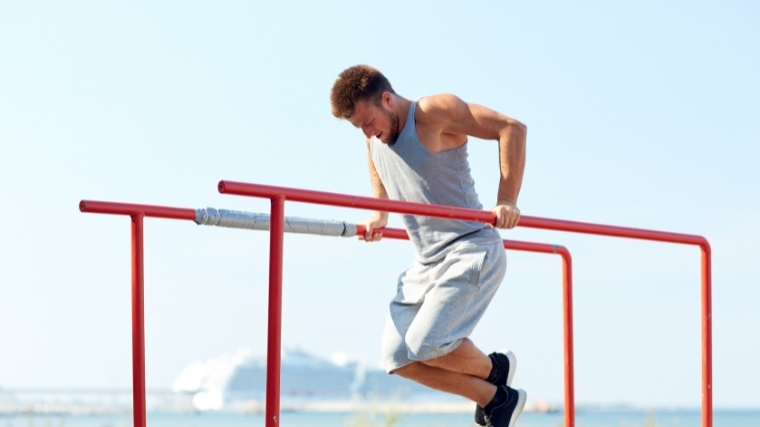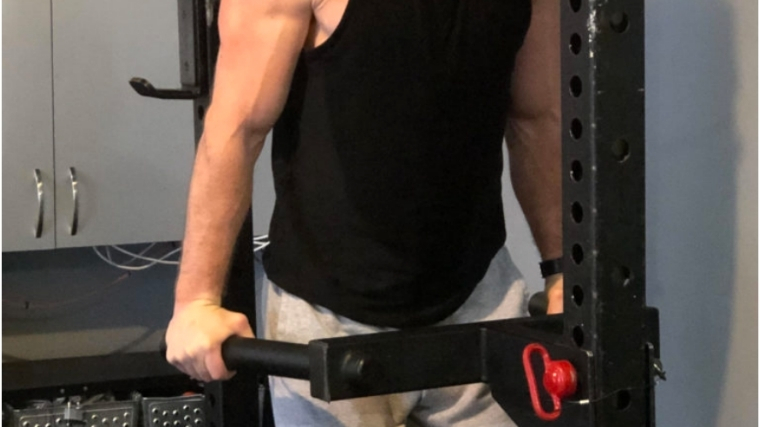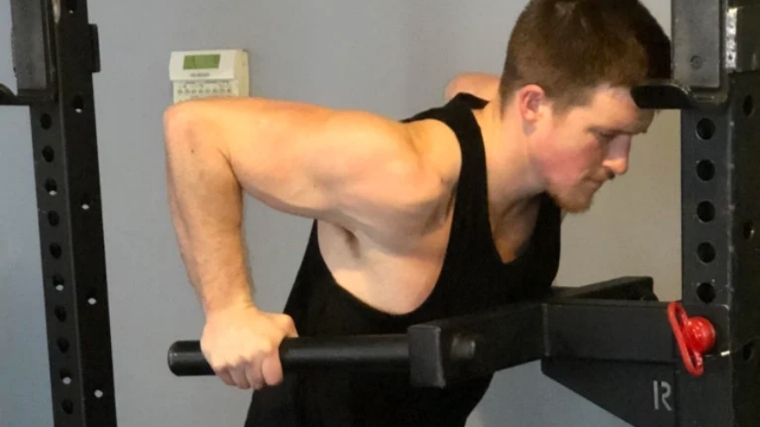The dip develops serious upper body strength, stimulates triceps muscle growth, and improves lockout performance in the bench press for strength, power, and fitness athletes. It’s also pretty accessible. Whether you own a modest home gym or belong to Globo Gym, you can do dips. Heck, if you own two chairs, you can still bang out more dips than a Super Bowl party.
It’s a simple movement that brings on big gains. Still, there’s a right way and a wrong way to dip. Below, we’ll tell you how to dip the right way and outline some benefits, alternatives, and programming recommendations.
- How to Do the Dip
- Benefits of the Dip
- Muscles Worked by the Dip
- Who Should Do the Dip
- Dip Sets, Reps, and Programming Recommendations
- Dip Variations
- Dip Alternatives
- Frequently Asked Questions
How to Do the Dip
The step-by-step guide below focuses specifically on bodyweight dips performed on parallel bars.
Step 1 — Get Set
Stand between the dip bars, ideally ones that allow the hands to be relatively close (like one to two inches) outside of shoulder-width, and set your hands on them. Squeeze your shoulder blades together and squeeze the bar hard.
Form Tip: Keep the elbows tucked into the body, which will help isolate the shoulders more.
Step 2 — Lower Your Body
Flex our elbows and lower your body, keeping your torso upright until your elbows are bent 90 degrees.
Form Tip: Be careful not to let the triceps flare outwards.
Step 4 — Press Yourself Back Up
Drive through your palms to raise your body back to the starting position. Your torso should be nearly vertical, maybe a slight lean forward.
Form Tip: Flex the triceps hard at the top (like you are in a photo shoot).
Benefits of the Dip
If you start to incorporate dips into your routine, here are three benefits you can expect to gain.
Improved Lockout Strength
The triceps are involved in elbow extension, which is the final phase of movements like the bench press, jerk, overhead press, push press, handstand push-up, and more. Often, lifters who struggle with the lockout phases of a movement need to add accessory movements to their training program to help shore up any weaknesses.
Greater Overhead Stability
The triceps help stabilize the elbows in the overhead position, making them a key muscle group to develop (in addition to the stabilizers of the wrist, scapular region, and shoulders) for overhead athletes. More overhead stability is key for weightlifters, specifically in the top positions of clean & jerks and snatches.
Bigger Arms and Chest
The triceps muscle takes up more than half of the arm, which means the larger those triceps get, the larger your arms get. For those of you on a quest for 22-inch pipes, be sure to work your triceps hard, as they will contribute greater o arm size than the biceps. The chest is also a key player in the dip more toward the bottom of the movement. So, the dip equally taxes the chest muscle for more size and strength.
Muscles Worked by the Dip
The dip is an upper body exercise that can add strength and muscle mass to the triceps and chest. That said, it may also add some volume to the anterior shoulder as well.

Triceps
The triceps are used to lift the lifter upwards as they are responsible for elbow extension. The dip is a good exercise to target the long and lateral heads of the triceps and can be a key triceps exercise for muscle growth.
Pectorals
The pectoral muscles (chest) are targeted during the dip and aid the triceps in pushing the lifter upwards. When done properly, this can help target the lower pecs.
Front Deltoids
In most pressing movements, the front deltoid (shoulder) is used. Some individuals may find the dip can aggravate or really tax the anterior shoulder capsule, which may mean your form is incorrect, or you need to do other exercises to isolate the triceps and pecs.
Who Should Do the Dip?
Anyone really. Below are the main athletes who can benefit from adding dips to their routine.
Strength and Power Athletes
Strength and power athletes can benefit from including the dip when triceps strength, hypertrophy, and overall upper-body mass are the priorities.
- Powerlifters and Strongman Athletes: Use the dip to develop the triceps, a vital muscle group during the bench press and other overhead pressing movements. Using the dip to isolate the triceps (and even the chest) can help to enhance further muscle hypertrophy and aid in overall upper body strength and mass development.
- Olympic Weightlifters: The triceps are key in proper elbow extension and overhead lockout strength. Stronger triceps will often correlate with greater overhead stability and strength in the snatch and jerk positions.
General and Functional Fitness
The dip can increase upper body strength and development, aid in increasing overhead stability and pressing performance, carry over to gymnastic-based movements (such as muscle-ups and other calisthenics), and be performed at nearly any gym.
Dip Sets, Reps, and Programming Recommendations
Here are three ways to program dips.
To Gain Muscle
Start by performing three to five sets of eight to 15 repetitions, with 90-120 second rest periods with moderate to heavy loads. This rep range ensures your triceps are under tension for the right amount of time. If your body weight is no longer a challenge, you’ll need to add weight to your dips.
To Gain Strength
To gain strength, you’ll want to add weight via a dipping belt. Do three to five sets of five to 10 repetitions with 90-120 second rest periods with moderate to heavy loads. While there are no exact guidelines for strengthening the triceps using dips, manipulating lifting tempos, loads, and partial ranges of motion (at times) can all be used to facilitate strength development further.
To Improve Muscle Endurance
Endurance is all about performing a lot of reps with a short rest time. Do two to three sets of 20-30 repetitions with 45-60 second rest with light to moderate loads.
Dip Variations
Below are three dip variations you can do to improve strength, size, and overall muscle growth of the chest, triceps, and upper body.
Elevator Dips
Elevator dips are a series of partial range of motion dips (similar to 21s for biceps curls) that force a lifer to develop strength and control at various stages throughout the range of motion. To do this, a lifter starts at the top or bottom of the lift and performs a set number of repetitions to the halfway point, pausing for a second, and then descending into the full rep, pausing, and coming back up. You can get creative and add pauses at whatever level you would like to increase body control, muscle tension, and difficulty.
Weighted Dips
This is the same movement as a standard bodyweight dip, but with added weight. You can secure a dipping belt around your waist and add weight plates or hold a dumbbell between your thighs.
Ring Dips
The ring dip is an advanced variation of the standard dip as it is performed on gymnastic rings, which require a greater amount of joint stabilization, muscle coordination, and strength. The movement is performed on rings to increase range of motion, application to movements like muscles ups, and often increases time under tension via suspension training.
Dip Alternatives
Below are three dip alternatives that can be done to vary programming, challenge lifters, and more.
Close-Grip Push-Up/Bench Press
The close-grip push-up and/or bench press is a fundamental exercise to build raw strength and muscle mass in the triceps and chest muscles. You can use this exercise to target many of the same muscle groups as the dip, with much more load and often less strain on the anterior shoulder.
Handstand Push-Up
The handstand pushup (HSPU) is a bodyweight exercise that primarily targets the triceps and shoulders. This exercise does a wonderful job of increasing triceps strength. Further attack the triceps by making sure to keep the elbows nearly parallel to one another during the movement, rather than letting them flare outwards.
Floor Press
The floor press is a movement that targets the triceps (elbow extension) and the chest, similar to the dip. While the angles are slightly different between these two exercises, the close-grip bench offers lifters the opportunity to develop serious strength and muscle hypertrophy, especially when the dip may cause shoulder discomfort (some lifters may experience this).
FAQs
Is there a substitute for dips at home?
When training dips at home, without a dip bar, you can do bench dips or close-grip push-ups to get a similar muscular loading and hypertrophy effect on the triceps and chest.
Dips hurt my shoulders. What can I do instead to target the same muscles?
Dips are not inherently bad for the shoulders. However, the dip can sometimes aggravate the shoulders in some individuals. While this can often be remedied with learning proper technique, lifters can also swap out dips for movements like close-grip bench presses, close-grip push-ups, and cable pushdowns to hit the triceps muscle in a similar manner as the dip.
How heavy can you train weighted dips?
Generally speaking, adding weight to the dip can be beneficial to gain strength and muscle. I recommend training no less than five reps per set, which means the weight itself can vary based on your strength.
Featured image: Syda Productions/Shutterstock


